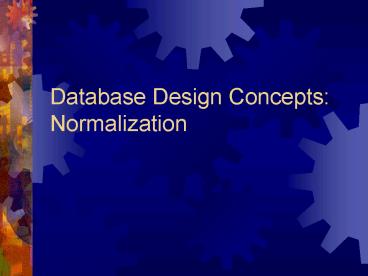Database Design Concepts: Normalization - PowerPoint PPT Presentation
1 / 15
Title:
Database Design Concepts: Normalization
Description:
Homer Simpson. Smith. 140. Ned Flanders. Hicks. 160. Jerome Clark. Smith. 170. Marge Simpson. Jones. 180. Willie Nelson. Hicks. 190. Clark Kent. Wilson ... – PowerPoint PPT presentation
Number of Views:113
Avg rating:3.0/5.0
Title: Database Design Concepts: Normalization
1
Database Design Concepts Normalization
2
Objectives
- Present the idea of functional dependence.
- Define first normal form (1NF), second normal
form (2NF), and third normal form (3NF). - Describe the problems associated with tables
(relations) that are not in 1NF, 2NF, or 3NF,
along with the mechanism for converting to all
three. - Discuss the problems associated with incorrect
conversions to 3NF.
3
The Normalization Process
- A set of steps that enables you to identify the
existence of potential problems, called update
anomalies, in the design of a relational
database. - The goal of normal forms is to allow you to take
a table or collection of tables and produce a new
collection of tables that represents the same
information but is free of problems.
4
Normal Forms
- First Normal Form
- Multi-value attributes have been removed
- Second Normal Form
- Partial dependencies have been removed
- Third Normal Form
- Transitive dependencies have been removed
5
Functional Dependencies
A constraint between two attributes or two sets
of attributes.
- SSN Name, Address, Birthdate
- VIN Make, Model, Color
- ISBN Title, Author_Name
SSN, VIN and ISBN are all Determinants of their
respective tables
6
Example of Functional Dependencies
Employee1
EMP_ID
Name
Dept
Salary
Employee2
EMP_ID
Course_Title
Name
Dept
Salary
Date_Completed
7
Table with Multi-valued attributes
8
First Normal Form
A relation which contains no multi-valued
attributes.
9
Second Normal Form
- Must be in First Normal Form to start with
- If the primary key consist of only one attribute
then you are already in 2NF. - No non-key attributes exist in the relation.
- Every non-key attribute is functionally dependent
on the full set of primary key attributes.
10
Example of Partial Functional Dependencies
Employee2
EMP_ID
Course_Title
Name
Dept
Salary
Date_Completed
Causes Modification, Insert and Delete Anomalies.
11
Second Normal Form 2
Employee1
EMP_ID
Name
Dept
Salary
Emp_Course
EMP_ID
Course_Title
Date_Completed
12
Third Normal Form
- Relation must be in Second Normal Form to begin
with - The Relation must not have any transitive
dependencies. - Transitive Dependency
- A functional dependency between two or more
non-key attributes
13
Example of Transitive Dependencies
Insertion Anomalies
Sales
Deletion Anomalies
Modification Anomalies
14
Third Normal Form 2
Sales Person is not a good Primary key
15
Third Normal Form 3































